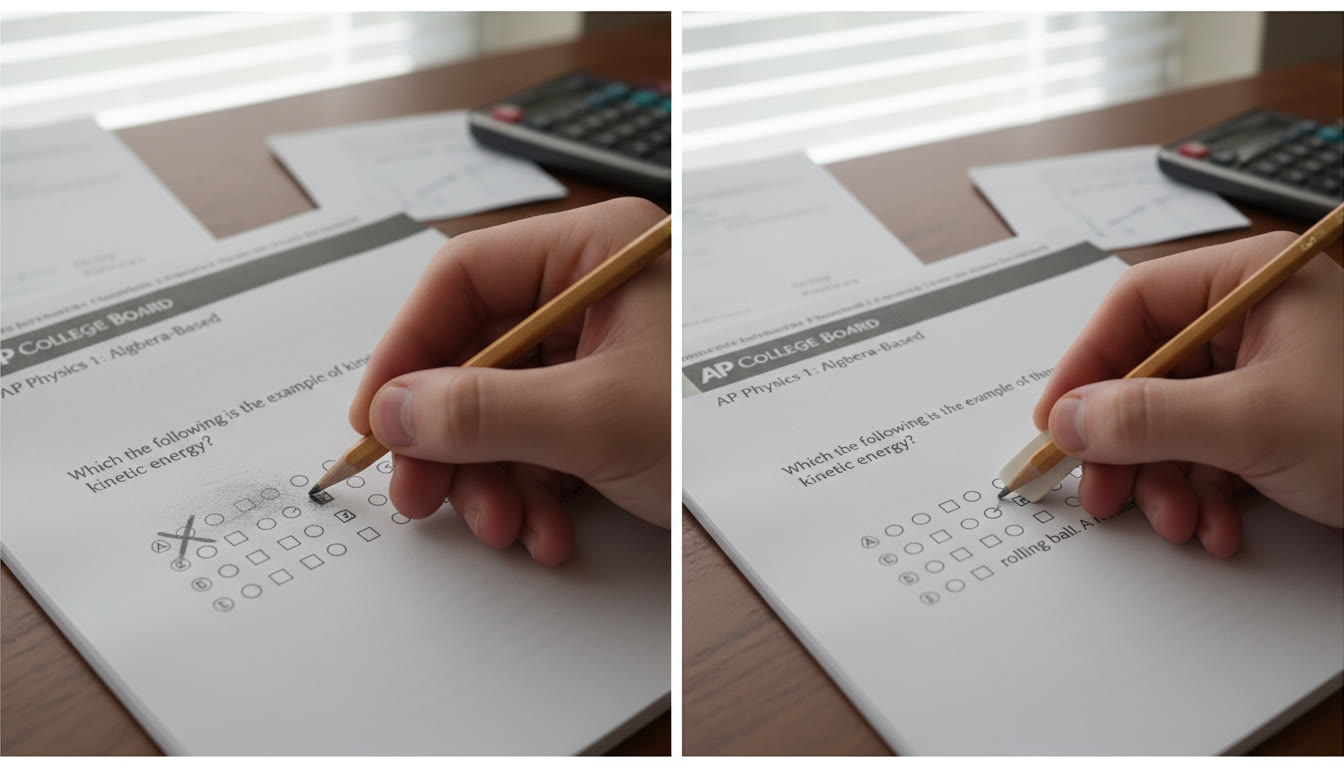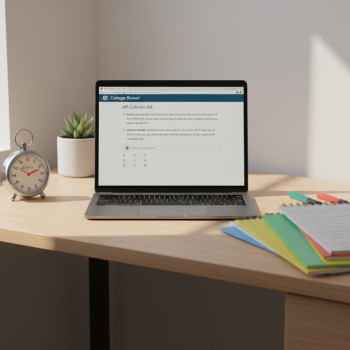Why a Tiny Mark Can Make a Big Difference
If you’ve ever sat in an AP exam and wondered whether to neatly erase or simply cross out a wrong answer, you’re not alone. That small decision — to spend precious seconds erasing or to scribble an X and move on — sits at the intersection of two competing forces: speed and neatness.
Both matter. Speed gets you to the next question and keeps you from running out of time. Neatness helps graders understand your thinking and can secure partial credit on free-response sections. The trick is knowing when each one matters most, and how to make that choice consciously rather than reactively.

Two Exam Worlds: Multiple-Choice vs Free-Response
Let’s separate the battlefield. The rules and priorities shift depending on question type.
- Multiple-choice: Speed and accuracy are king. For paper-based multiple-choice sections that use scantrons or answer sheets, neat erasing is important only when it prevents misreads. Otherwise, crossing out (on your scratch paper) and moving on often saves time.
- Free-response (FRQs): Readers score what they can see. Clear, organized work makes it easier to award partial credit. Crossed-out work is generally fine, but overly messy pages can obscure your correct reasoning.
Knowing which exam section you’re in and how it’s scored helps you pick a strategy that minimizes lost points and maximizes time.
What the Graders Want (and Don’t Care About)
AP readers look for evidence of understanding, not perfection. They can award points for correct reasoning even if an earlier step was wrong — as long as your correct work is visible and legible. That means a clear, concise final answer plus supporting steps are the most important elements on FRQs.
On many AP exam pages and guidance, graders are instructed to ignore clearly struck-through work that the student deliberately eliminated as incorrect. So a single, decisive cross-out (like an X or a neat line through irrelevant work) is usually interpreted as “this is not to be graded.”
Rule of Thumb
- If the crossed-out work hides later correct work or is so messy that it bleeds into other lines, erase or rewrite a clean version.
- If the crossed-out work is short, clearly marked, and not interfering with the rest of your answer, crossing out is faster and perfectly acceptable.
When to Cross Out: Speed-First Situations
Crossing out is a pragmatic choice. Here are the moments during an AP exam when a quick X is the smarter move.
- Time-crunch on multiple-choice: You’ve eliminated two options and aren’t sure between the last two. Mark your scratch notes or test booklet with a quick X or star for later review, bubble the best current choice, and move on.
- Small arithmetic slip on FRQ: If an algebraic sign or a small arithmetic mistake won’t change your method and you can correct it quickly, cross it out and continue showing the correct process.
- Working draft that’s not needed: Short incorrect steps that you realize are wrong — cross them out and keep your clean, corrected steps visible.
- Rescued answers: If you discover a better approach later and can point to it, cross out the earlier path and make the correct method prominent.
Practical Tips for Crossing Out
- Use a single, decisive strike or an X. Multiple messy scribbles look chaotic and can obscure other content.
- Leave the correct final answer clearly boxed, circled, or underlined so a reader’s eye goes straight to it.
- If you change a multiple-choice bubble, erase the previous bubble on the answer sheet fully; don’t rely on crossing out bubbles on paper that won’t be scanned.
When to Erase: Neatness-First Situations
Erasing is time-consuming — but sometimes it can save you points.
- Complex derivations: When you’re building a multi-step argument and an early error would mislead a grader scanning your work, erase the offending part and rewrite the steps cleanly.
- Messy handwriting or heavy crossings: If your crossed-out lines make the page illegible or bleed through, erase what’s unnecessary and tidy up.
- Bulky diagrams: For labeled diagrams, graphs, or geometric proofs where clarity matters, erase the incorrect sketch and redraw if necessary.
- Answer documents that are scanned: If the scanning method penalizes heavy marks or stray lines, careful erasing prevents misinterpretation.
How to Erase Efficiently Without Losing Time
- Keep a clean eraser (or two) on your desk; a crumb-free eraser removes marks faster and cleaner.
- Practice neat, decisive strokes during study so your initial writing is less likely to need heavy erasing.
- If erasing will take more than 15–20 seconds, weigh the trade-off: is the potential point gain worth the lost time?
Balancing Act: A Simple Decision Flow
Here’s a lightweight decision process you can use on exam day so you don’t waste time deliberating.
| Situation | Speed Priority? | Neatness Priority? | Action |
|---|---|---|---|
| Multiple-choice quick choice | High | Low | Cross out on scratch, bubble best guess, mark for review |
| Single arithmetic mistake in multi-step FRQ | Medium | High | Erase minor error if it obscures reasoning; otherwise cross out and annotate correction |
| Entire approach is wrong | Low | High | Erase and rewrite a clear approach if time allows; otherwise cross out and clearly present new approach |
| Short scratchwork no longer needed | High | Low | Cross out and move on |
Study Habits That Make Crossing Out Safer
Your in-exam behavior is shaped by what you practice. If you prepare with messy habits, crossing out will cost you clarity. Train smarter so that both crossing out and erasing become efficient tools rather than reactive panics.
- Write legibly under timed conditions. Do full practice FRQs with a timer and force yourself to make your handwriting readable at pace.
- Label key steps. Use short labels like “Step 1,” “Answer,” or “Plug-in” to guide the grader through your logic even if you cross out earlier missteps.
- Practice deliberate crossing. Train yourself to make a single, clean X or line through discarded work — it’s faster and neater than frantic scribbles.
- Keep an answer box. Make a habit of boxing or underlining the final answer in every FRQ. That ensures readers don’t have to hunt through crossed-out material.
Example Practice Drill
Set a 35-minute block. Complete one FRQ from your course’s practice set. Intentionally make a wrong step, cross it out with a single X, then continue. After you finish, review if the grader could clearly follow your corrected path. If not, practice again focusing on clarity.
Time Management: How Many Seconds Are You Really Saving?
Seconds add up. On a long exam, spending an extra 30 seconds erasing on five problems could cost you time to attempt another question. Conversely, messy crossings that cause a grader to miss a correct step could cost points.
Here’s a quick mental accounting to keep in mind while you work:
- Erasing thoroughly: ~15–45 seconds depending on size and neatness.
- Single-line crossing: ~2–4 seconds.
- Rewriting a step cleanly: ~45–90 seconds.
Those numbers aren’t exact but are useful for trade-off thinking: if erasing or rewriting will take more than a minute and the probable point gain is small, prefer crossing and clarify the correct work.
Tools and Test-Day Logistics
Small tools can make a big difference.
- Use a high-quality pencil and an eraser that doesn’t smear. Mechanical pencils can produce very thin lines that are quick to erase; traditional pencils can be easier to cross out decisively.
- On digital or hybrid AP exams where you type or use a stylus, learn the interface beforehand: many digital platforms have clear erase/undo functions that behave differently from physical erasers.
- Bring a watch or use room clocks to avoid losing sight of time while you tidy up unnecessary marks.
Real-World Context: Why Graders Accept Crossed-Out Work
Exam scoring is designed to judge your demonstrated knowledge. Readers are trained to award points where evidence exists. A crossed-out calculation that’s replaced by a correct derivation won’t cost you credit if the correct path is readable. In many AP subject guides and exam tips, students are explicitly told to mark incorrect work clearly (for example, an “X” or a line) instead of wasting time erasing. That guidance reflects how graders operate in practice.
Case Studies: Subject-Specific Nuances
Different AP subjects have distinct expectations. Here’s how crossing out vs erasing plays out in a few common AP exams:
- AP Calculus and Precalculus: Show your steps. Calculations can be crossed out if the corrected work is clear. Box final answers so graders can find them quickly.
- AP Physics: Diagrams and unit labels matter. If a wrong diagram will confuse your final reasoning, redraw; small arithmetic can be crossed out.
- AP Chemistry and Biology: Balanced equations and labeled diagrams should be legible. Cross out short blunders; redraw if structural errors mislead interpretation.
- AP English and History FRQs: Train for legibility. If you cross out a sentence, make sure the corrected sentence clearly replaces it; messy crossings in essays may disrupt flow but don’t necessarily lose points if your final argument is intact.
Practice Playbook: Build a Personal Exam Day Routine
Turn this advice into a simple routine you use every practice test. Repetition makes decision-making automatic on exam day.
- Begin each FRQ page by leaving a 1–2 line margin at the top for labeling (“FRQ 1 — Part (a)”).
- If you change strategy mid-way, write a one-line note like “New method below” so a grader understands context.
- Always box or underline the final numeric or conceptual answer.
- Practice making one clean cross-out stroke instead of erasing for minor errors — time the difference so you feel it viscerally.
How Personalized Help Can Speed the Learning Curve
Learning when to cross out and when to erase is a skill best developed in context. That’s where targeted tutoring can accelerate progress: working 1-on-1 with an experienced tutor helps you identify patterns in the mistakes you make under pressure and develop a personal exam strategy. Sparkl’s personalized tutoring, for example, offers tailored study plans and expert tutors who help students practice decision-making under timed conditions and use AI-driven insights to pinpoint which types of errors are costing time or points.
What to Ask a Tutor
- Can we simulate timed sections focusing only on my tendency to overwrite or erase?
- Which of my mistakes would lose partial credit and which are safe to cross out quickly?
- Can we create a rubric for when to erase vs cross out for my specific AP subjects?
Common Mistakes and How to Avoid Them
Here are a few pitfalls students fall into and how to fix them.
- Over-cleaning: Spending too long erasing when a quick cross-out would do. Fix: set a rule — if erasing takes longer than 20 seconds, cross out and move on.
- Messy cross-outs: Illegible scribbles that obscure correct work. Fix: practice making a single clean strike or X.
- Forgetting to update answers: Changing your reasoning but not clearly marking the final answer. Fix: always box or underline your final answer and write “Final” if helpful.
Final Checklist for Exam Day
- Keep two good erasers and a sharpened pencil (or compatible mechanical pencil) in your test kit.
- Use a consistent marking system: X for discarded work, box/circle for final answers.
- When in doubt, favor clarity: a clear crossed-out mark plus a clean final answer usually preserves points and saves time.
- Practice these decisions under timed conditions until they become muscle memory.
Parting Thought
Crossing out versus erasing isn’t a moral choice — it’s a tactical one. The smarter student isn’t the neatest or the fastest in isolation; it’s the one who makes informed trade-offs and practices them until choices become automatic under pressure. Train for both speed and clarity. Use crossing out as a deliberate tool, not a panic reaction. When neatness matters, erase or rewrite quickly and clearly. Over time you’ll develop an exam persona that blends both: fast where you must be, and impossibly clear where it counts.
And if you want tailored drills, rubric-building, and timed practice that reflect your specific AP exams, consider working with a personalized tutor to sharpen those trade-offs — a focused investment that saves time and points on test day.

Good luck — study smart, practice your marks, and let the small choices on the page add up to a big win on exam day.




















No Comments
Leave a comment Cancel